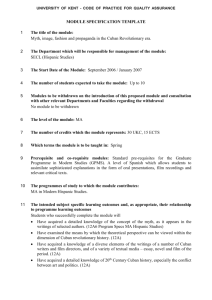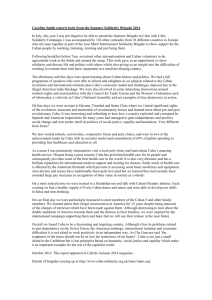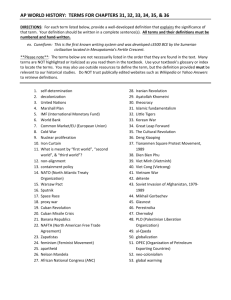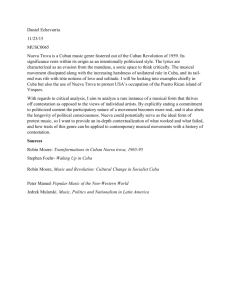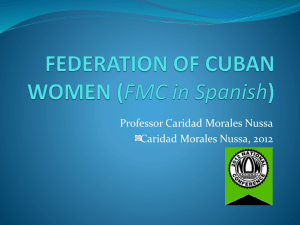An Economic Evaluation of the Foreign Investment Law of Cuba by
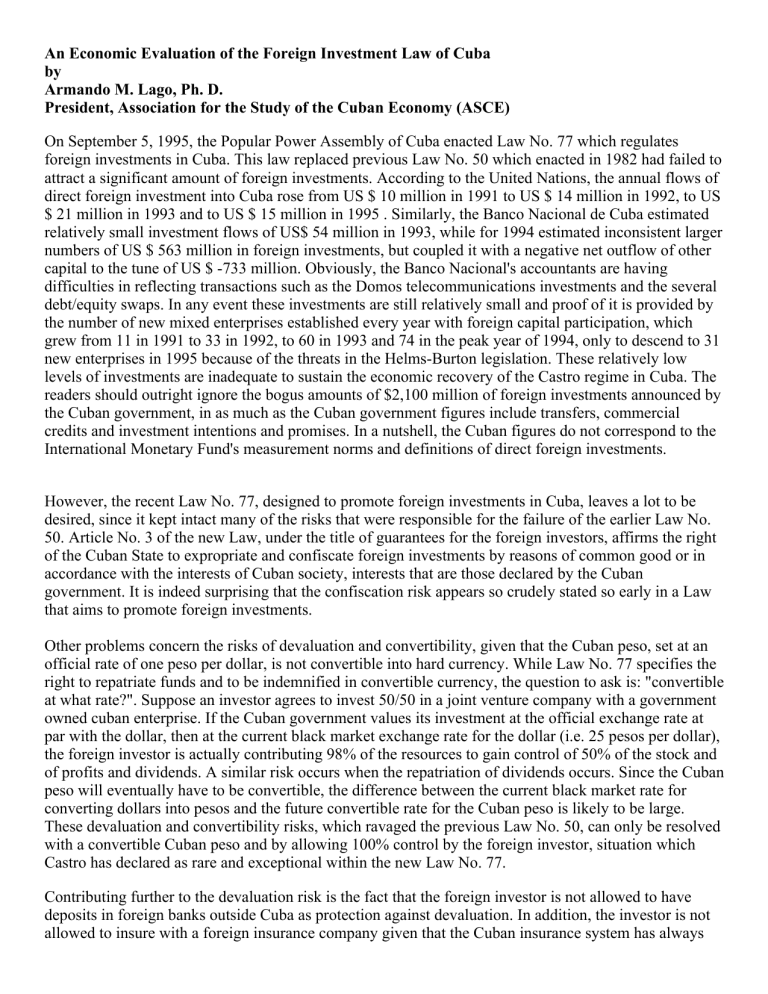
An Economic Evaluation of the Foreign Investment Law of Cuba by
Armando M. Lago, Ph. D.
President, Association for the Study of the Cuban Economy (ASCE)
On September 5, 1995, the Popular Power Assembly of Cuba enacted Law No. 77 which regulates foreign investments in Cuba. This law replaced previous Law No. 50 which enacted in 1982 had failed to attract a significant amount of foreign investments. According to the United Nations, the annual flows of direct foreign investment into Cuba rose from US $ 10 million in 1991 to US $ 14 million in 1992, to US
$ 21 million in 1993 and to US $ 15 million in 1995 . Similarly, the Banco Nacional de Cuba estimated relatively small investment flows of US$ 54 million in 1993, while for 1994 estimated inconsistent larger numbers of US $ 563 million in foreign investments, but coupled it with a negative net outflow of other capital to the tune of US $ -733 million. Obviously, the Banco Nacional's accountants are having difficulties in reflecting transactions such as the Domos telecommunications investments and the several debt/equity swaps. In any event these investments are still relatively small and proof of it is provided by the number of new mixed enterprises established every year with foreign capital participation, which grew from 11 in 1991 to 33 in 1992, to 60 in 1993 and 74 in the peak year of 1994, only to descend to 31 new enterprises in 1995 because of the threats in the Helms-Burton legislation. These relatively low levels of investments are inadequate to sustain the economic recovery of the Castro regime in Cuba. The readers should outright ignore the bogus amounts of $2,100 million of foreign investments announced by the Cuban government, in as much as the Cuban government figures include transfers, commercial credits and investment intentions and promises. In a nutshell, the Cuban figures do not correspond to the
International Monetary Fund's measurement norms and definitions of direct foreign investments.
However, the recent Law No. 77, designed to promote foreign investments in Cuba, leaves a lot to be desired, since it kept intact many of the risks that were responsible for the failure of the earlier Law No.
50. Article No. 3 of the new Law, under the title of guarantees for the foreign investors, affirms the right of the Cuban State to expropriate and confiscate foreign investments by reasons of common good or in accordance with the interests of Cuban society, interests that are those declared by the Cuban government. It is indeed surprising that the confiscation risk appears so crudely stated so early in a Law that aims to promote foreign investments.
Other problems concern the risks of devaluation and convertibility, given that the Cuban peso, set at an official rate of one peso per dollar, is not convertible into hard currency. While Law No. 77 specifies the right to repatriate funds and to be indemnified in convertible currency, the question to ask is: "convertible at what rate?". Suppose an investor agrees to invest 50/50 in a joint venture company with a government owned cuban enterprise. If the Cuban government values its investment at the official exchange rate at par with the dollar, then at the current black market exchange rate for the dollar (i.e. 25 pesos per dollar), the foreign investor is actually contributing 98% of the resources to gain control of 50% of the stock and of profits and dividends. A similar risk occurs when the repatriation of dividends occurs. Since the Cuban peso will eventually have to be convertible, the difference between the current black market rate for converting dollars into pesos and the future convertible rate for the Cuban peso is likely to be large.
These devaluation and convertibility risks, which ravaged the previous Law No. 50, can only be resolved with a convertible Cuban peso and by allowing 100% control by the foreign investor, situation which
Castro has declared as rare and exceptional within the new Law No. 77.
Contributing further to the devaluation risk is the fact that the foreign investor is not allowed to have deposits in foreign banks outside Cuba as protection against devaluation. In addition, the investor is not allowed to insure with a foreign insurance company given that the Cuban insurance system has always
the first option. Thereby the purchase of reinsurance overseas is basically blocked.
According to the new law, every investment above US$ 10 million must be negotiated individually with the Council of Ministers, bureaucratic process which results in delays and higher opportunity costs for the investor. In addition other affected government agencies could intervene in the approval process, further complicating and delaying the negotiation process. However, this requirement to negotiate each investment on a per case basis will at least allow the foreign investor to specifically protect himself in the negotiation against the risks described earlier.
Another important risk concerns liquidity. If the investor desires to sell his stock in the joint venture to a third party, he must first secure the consent of the Cuban government, fact which increases risks. While the Spanish hotel firm Guitart was recently allowed by the Cuban government to sell their joint venture participation to another foreign firm, uncertainty concerning liquidity persists in the new law.
The Cuban government's intention of controlling the foreign investor and direct him toward joint ventures manifests itself in the types of legal forms permitted for the investment. The new law persists in not allowing limited liability companies and general partnerships, that is, in disallowing types of organizations that are allowed in other countries that compete with Cuba for foreign investments.
One interesting aspect of the new law is that allows for investment by Cuban exiles, subject to the result of the individual case by case negotiation. Obviously, the Cuban government is paying attention to
China, where the overseas Chinese account for roughly the majority of foreign investments, and to
Vietnam. where the Vietnamese exiles are accounting for a growing proportion of foreign investments.
However, the decision to allow the Cuban exiles to invest in Cuba is inconsistent with the government decision to bar investments by current residents of Cuba.
The current practice among Spanish investors is to stipulate in the negotiations with the Cuban government that conflicts will be resolved by the rulings of French arbitration services in France.
However, the new Law No. 77 specifies that conflicts will be resolved in Cuban judicial courts, which as we all know are not independent of the Cuban government. It thereby becomes important that the foreign investor protects himself in the individual negotiation process by insisting in the jurisdiction of foreign arbitration services as well as by requiring in the corporate by laws on unanimity and/or the right of veto in the decisions of the joint venture.
The new legislation persists in denying the foreign investor the right to contract for labor directly. Instead he must employ laborers sent by the government agency in charge of labor contracting. These laborers are paid in pesos at approximately 300 pesos (US $ 12.00 at the current black market rate of 25 pesos per dollar per month), while the government contracting agency receives US$ 300 (7,500 pesos at the current black market rate) per month; that is the cuban laborer is capturing only 4% of the wage in dollars that the government agency is billing the joint venture. These practice has contributed to the fact that the labor share of the value added by the joint venture is between 2% and 5%, depending on the sector where investment occurs. This labor share is lower that the labor share of value added in times of Karl Marx's writings. According to Simon Kuznets the labor share of national income in Europe was between 36% in
France (1853), and 47% in England (1860-69). Given that Marx referred to these rates as evidence of the exploitation of labor, he must be turning in his grave at the thought of what the marxist-leninists cubans are doing in his name. There is also evidence that there has been a reduction in the employment of blacks in the enterprises which are now part of joint ventures, situation very evident in the hotels and "diplo tiendas" catering to the tourists Thus the problem of discrimination and racism must be added to that of possible exploitation of labor.
The economics of investment analysis are straightforward. Higher investment returns are required to
compensate for higher risks, thus necessitating the selling of Cuban resources and assets at lower prices by the Cuban government; otherwise the level of investment will fall. No wonder then that the Cuban government is going through a fire sale of Cuban resources. In summary, by largely maintaining the high level of risks in the previous legislation, the new Law No. 77 contains structural defects which will hamper the attraction of foreign investments into Cuba. Foreign investors need to be appraised of the risks involved and to protect themselves from exorbitant risks in the individual negotiation process.
Foreign Investors of the World: Unite, but Beware! You all have more to lose than chains!




